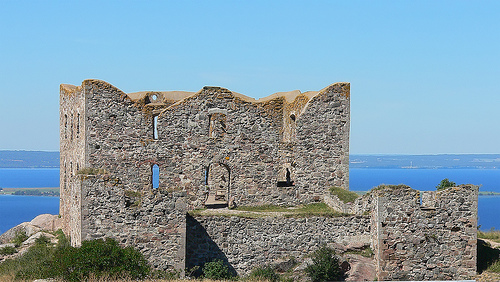

Location: Gränna, Småland Map
Constructed: 1640s by Count Per Brahe
Brahehus is the ruins of a 17th-century pleasure palace located near Gränna in Jönköping County, in the province of Småland, southern Sweden. Perched on a hilltop 270 meters above sea level and 180 meters above Lake Vättern, it offers panoramic views of the lake, the island of Visingsö, and the surrounding landscape. Built in the 1650s by Count Per Brahe the Younger as a tribute to his wife, Kristina Katarina Stenbock, it is sometimes romantically referred to as the "Swedish Taj Mahal." Never intended as a permanent residence, the castle served as a venue for entertaining guests and enjoying the scenery before being destroyed by fire in 1708. Today, the ruins are one of Sweden's most visited historical sites, blending romantic decay with breathtaking vistas, and are accessible year-round as a free public attraction. Coordinates: 58°03′10″N 14°30′17″E. With its proximity to the E4 highway, it serves as a convenient stop for travelers, combining historical interest with natural beauty.
Brahehus was conceived in the 1630s by Count Per Brahe the
Younger, a prominent Swedish nobleman and governor, as part of
his efforts to create a grand estate landscape in the county of
Visingsborg. The site was originally a rocky hill known as
"Gudsbacka" or "Grusbacka," chosen for its commanding views.
Construction began in 1638, inspired by Brahe's travels to
German and Italian principalities, and was intended as a dower
house for his wife, Kristina Katarina Stenbock. However, she
died in 1650, just before completion in 1651. The castle formed
the eastern tip of a symbolic triangle with Västanå Manor to the
south and Visingsborg Castle on Visingsö to the west, creating a
princely vista over the newly founded town of Gränna, whose
streets were aligned to face Brahehus.
Never permanently
inhabited, Brahehus functioned as a lavish entertainment venue
where guests enjoyed wine, food, and the spectacular scenery.
After Per Brahe's death in 1680, the estate passed to his
successor, Nils Brahe the Younger, who showed little interest.
During the Great Reduction under King Charles XI, the property
was confiscated by the Swedish Crown, and its movables were
auctioned in Jönköping from 1697 to 1702. Abandoned and empty,
the castle was destroyed by a fire originating from nearby
Uppgränna on September 29, 1708. In the 19th century, the ruins
became a romantic attraction for travelers, depicted in artworks
showing their picturesque decay. Restoration efforts began in
the early 20th century, with plans from the Royal Academy of
Letters in 1891, actual work from 1911 to 1913, and further
renovations up to 2011–2012. The construction of the E4 motorway
in 1972, including a service area just 50 meters away, was
controversial but increased accessibility.
Brahehus exemplifies Renaissance architecture with native
Swedish elements and Palladian influences, inspired by castles
in the Rhine Valley and Mälaren Valley. The original structure
was a square main building measuring 22 meters per side, with
two spired side towers—one northern for guards and weapons,
possibly including a prison cellar, and one southern with a well
and kitchen. It featured two stories above a cellar: the ground
floor housed the kitchen, while the upper floor contained halls,
bedrooms (including one for the Count and Countess, and two for
guests), and richly decorated spaces. The roof included
glass-paneled lanterns surrounded by a balcony for views.
Facades were adorned with bright colors by court painter Johan
Johansson Werner, featuring scenes from Ovid's mythology, a
depiction of the Battle of Lützen, portraits of Brahe's
ancestors, and a panorama of the county with Brahe on horseback.
Symmetrical constructions, pillars, and foliage motifs enhanced
its grandeur. Today, only the stone walls remain, with arched
windows and remnants of towers, evoking a sense of romantic
ruin. The structure's dimensions were exaggerated in historical
engravings like those in Erik Dahlberg's Suecia Antiqua, but it
was designed to harmonize with the landscape.
The primary attraction of Brahehus is its stunning panoramic views over Lake Vättern and Visingsö Island, especially at sunset, which visitors describe as "breathtaking." Explore the ruins by walking the short path that circles the outer walls, allowing views from inside and outside. The lake-facing wall features windows that frame the water, ideal for contemplation or photography. Nearby, a rest area includes picnic spots, a playground, and a family-owned restaurant serving simple meals. A candy store offers fresh polkagris sticks, a local specialty, with demonstrations. The site ties into legends of romance and is depicted in historical artworks, adding cultural depth. For history enthusiasts, imagine the original opulent interiors while exploring the stone remnants.
Brahehus is open year-round and free to visit, with no restrictions on access. Located just off the E4 motorway, it's an easy stop for travelers between Stockholm and Gothenburg. Park in the large, free lot at the Brahehus rest area across the highway, then take a short, mostly flat trail under the road to the ruins (about 5-10 minutes). The site is suitable for families with older children, though uneven terrain may challenge young kids or those with mobility issues. Best visited in autumn for colorful foliage or winter for snowy scenery, but prepare for cold and wind without shelter. Allow 30-60 minutes to explore; bring a picnic or stop at the on-site cafeteria. Camping is not permitted at the ruins, but overnight parking is free at the rest area for vans or campers; nearby options include First Camp Gränna or Getingaryds Camping. No guided tours are standard, but the site is self-explanatory with informational signs. For more details, visit local tourism sites or the Jönköpings läns museum resources.